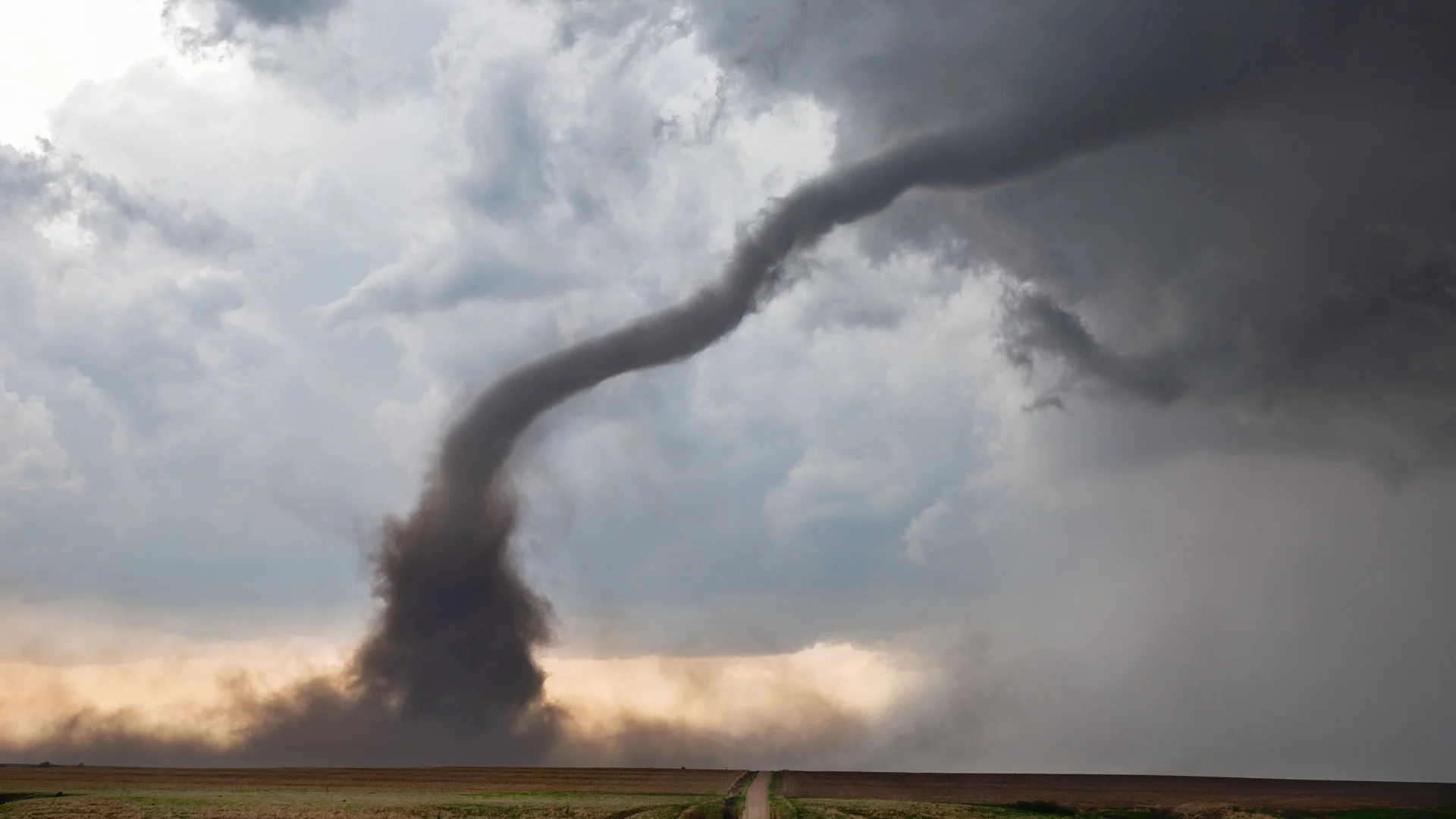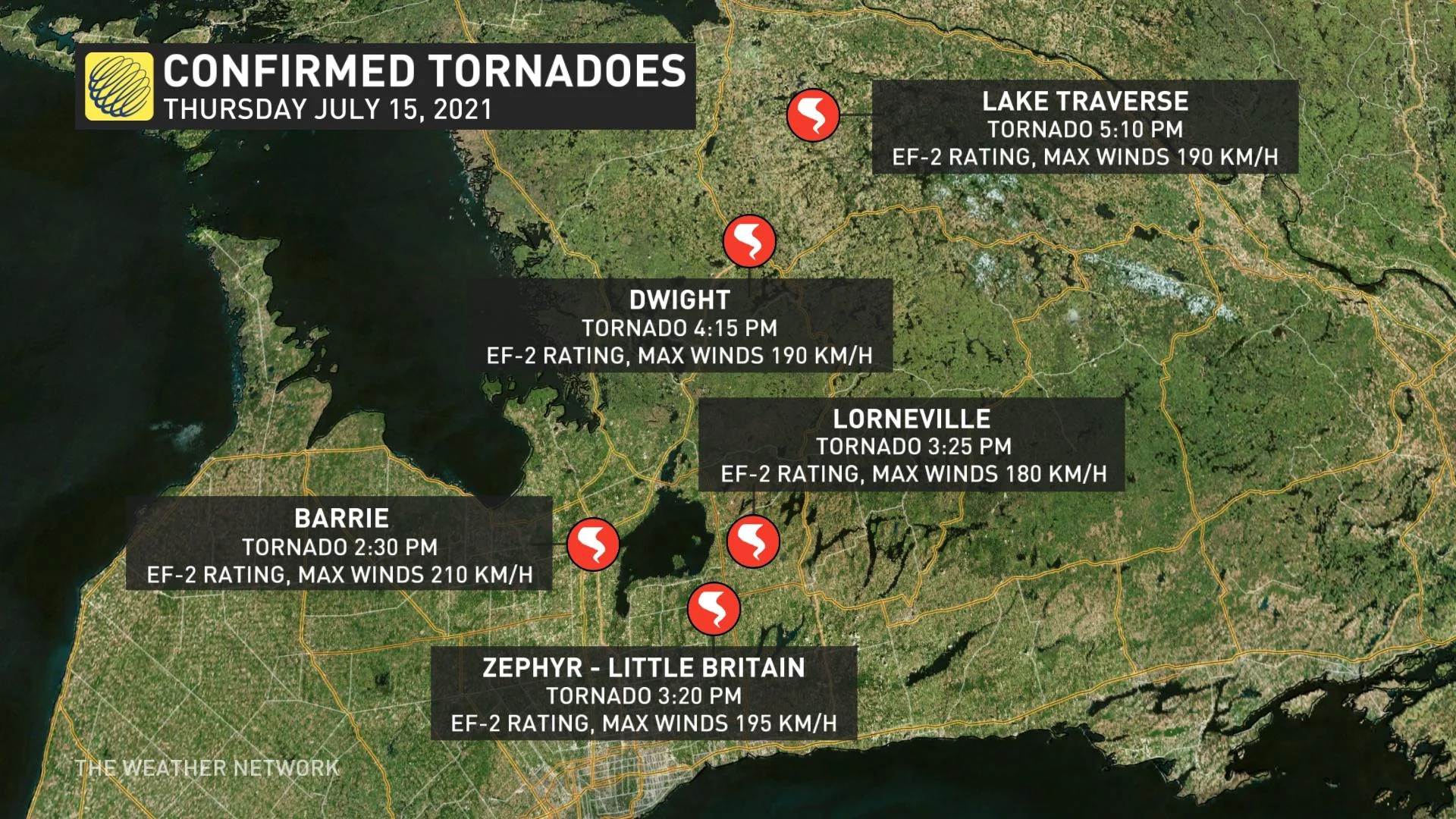
There's a big difference between an EF0 and EF5: Understanding tornado ratings
What's in a rating? Read on to find out.
It's summer, which means it's peak tornado season in Canada, a country that sees an average of 80 twisters a year.
Tornadoes are powerful, rotating systems that are associated with severe thunderstorms, but not all of them are created equal. After a storm has passed, Environment and Climate Change Canada provides a tornado rating - anything from EF0 to EF5.
What is the EF rating scale?
The Enhanced Fujita scale, more commonly referred to as the EF-Scale, became operational in the U.S. on February 1, 2007. It went into effect in Canada on April 1, 2013, replacing the Fujita scale (F-Scale) that had been used since 1971, created by Ted Fujita.
Both scales are similar, representing different degrees of damage, but the enhanced version was established to better account for observations made during ground surveys and to more accurately correlate wind speeds with storm damage.
On the EF-Scale, tornadoes range from 0 to 5, with 5s typically being the most violent (and thankfully, the rarest).
Assigning a tornado rating
In order to give a tornado an EF classification, surveyors look at the damage that was caused.
In other words, you can't point at a tornado and assess its rating simply by looking at it.
"With the current limitations of radar technology, it is not always easy or possible to get a true sample of the tornado, therefore, engineering comes into play," explains Weather Network meteorologist Matt Grinter.
"The Enhanced Fujita Scale is an intensity scale for tornadoes based on the damage they cause. The damage is assessed and, based on damage indicators, there is an estimated wind speed which is then related to a number from 0-5 on the EF Scale."
Here's a closer look at each rating, along with real-life examples.
EF-0
EF-0 tornadoes are considered 'weak' and usually pack winds around 105 and 137 kilometres per hour.
Typical damages include the loss of shingles, gutters, awnings, or metal siding. Shallow trees may fall over, and large trees could lose branches, potentially leading to downed power lines and outages.
Here's an example of the damage caused by an EF-0 tornado that hit Thornbury, Ontario, on October 26, 2020:
EF-1
With peak wind speeds between 138 and 177 kilometres per hour, EF-1 tornadoes can cause significant property damage.
Broken glass in windows and doors, loss of roof coverings, and collapsed garage doors aren't uncommon in this scenario, FEMA says. Winds are strong enough to push over mobile homes and cars.
Here's a look at the damage caused by an EF-1 tornado that formed on July 11, 2019, in Saint Roch de l'Achigan, Quebec. Three people were injured with the twister developed near a rural campsite.
EF-2
An EF-2 tornado is associated with winds around 178 and 217 kilometres per hour. That's strong enough to lift large structures, shift entire two-story homes off their foundations, flatten mobile homes, flip trains, topple large trees, and lift and throw cars.
We saw this terrifying scene play out on July 15, 2021, when powerful thunderstorms produced five EF-2 tornadoes in southern Ontario.

Multiple social media reports featured videos and images of large funnels and widespread destruction.
EF-3
Tornadoes with a rating of EF-3 and higher are rare and typically associated with the most significant damage.
With winds between 218 and 266 kilometres per hour, EF-3 tornadoes can uproot nearly any tree and demolish homes and buildings.
Between Sunday, April 12, and Monday, April 13, 2020, an outbreak hit southeastern portions of the U.S. during Easter Sunday and Monday, spawning 140 confirmed tornadoes across ten states, including thirteen EF3 tornadoes.
Here's a look at some of the destruction those storms caused:

EF-3 damage to a home in Monroe, Louisiana. (NWS Shreveport, LA/Wikipedia - Public Domain)

BorgWarner factory in Seneca, South Carolina, being hit by an EF-3 tornado. (NWS Greenville-Spartanburg, SC/Wikipedia - Public Domain)
EF-4
EF-4s are devastating, with peak winds between 267 and 322 kilometres per hour.
Houses in the path of an EF-4 will be leveled, structures will be blown off weak foundations, and large objects like dumpsters and cars will be lifted and thrown.
On August 3, 2018, an EF-4 tornado hit an area near Alonsa, Manitoba, flattening everything it touched and killing 77-year-old Jack Furrie. Two others were sent to the hospital with injuries.
More here:
EF-5
EF-5 tornadoes are exceptionally rare. To date, a total of 67 EF-5 tornadoes have occurred globally since 1950, with 59 happening in the U.S.
France and Germany have had two each, and one each in Argentina, Australia, Canada, and Italy.
Canada's took place in Elie, Manitoba on June 22, 2007.
At approximately 6:25 p.m., the twister touched down near the Trans-Canada Highway, moving southeast and sucking in a tractor-trailer. It then tracked south, hitting the town's flour mill and causing $1 million worth of damage in that one spot.
Video of the event shows a two-story home being ripped from its foundation and thrown 22 metres in the air before it was ripped apart.
Remarkably, nobody was injured or killed during the event, which caused $39 million in damages.
The highest wind speeds associated with the storm were between 420 and 510 kilometres per hour.
_Tornado safety
Should a tornado of any strength develop, seek underground shelter when possible - preferably in a basement.
In the absence of an underground room opt for a windowless interior room or hallway on the lowest level of a solid building.
Never try to outrun a tornado.
Keep cell phone and/or battery-operated radio handy so you can keep on top of tornado watches and warnings.
DO NOT go outside if a tornado is imminent or occurring in your area
Waterspouts
Waterspouts are usually relatively harmless, provided you're watching them from a distance.
They are non-supercell tornado that forms beneath a rapidly growing cumulus cloud. While spouts usually dissipate over the water, they may occasionally come ashore as a weak landspout tornado.
When that occurs, a tornado warning is normally issued for the area.
Unlike land-based tornadoes, which form from the top down, waterspouts tend to form at the surface and reach upward.
They thrive in cold environments, which is why they're most common in the late summer and into fall.
Dust devils
While dust devils may resemble tornadoes, they form under different circumstances and are normally less destructive.
Tornados typically develop under rotating thunderstorms, but dust devils materialize when there are clear skies and warm temperatures. When cold air moves aloft over the region and there is strong sunlight hitting the surface, it can cause rapid heating at the ground level, leading to a strong updraft that can pick up dust and rotate.
Dust devils aren't typically associated with significant property damage or injury, but the risk is always there. For that reason, they should be avoided whenever possible.
Header image: File photo via Canva Pro.











